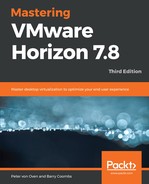These settings define the behavior of the delivery protocol for the virtual desktop machines and any user configurable options. The settings options are shown in the following screenshot:

You then have the following options for configuring the Remote Display Protocol:
- The first option in the Remote Display Protocol section is to select the Default display protocol. From the drop-down menu (23), you have the options of Microsoft RDP, PCoIP, or VMware Blast. Note that some of the display-based features are dependent on which protocol you choose. For example, session collaboration is only available when you use the Blast protocol.
- Next, you have the option to Allow users to choose protocol (24). If you set this to Yes, then the end user can choose the protocol. Typically, you would use PCoIP or VMware Blast as the default protocol, and not let the end user change this unless there is a specific use case that determines where another protocol is required. For example, if more than four screens are required, then you would use RDP, as this is the protocol that supports this, or maybe the end user could be connected behind a very strict outbound firewall that blocked the PCoIP port, 4172, and therefore would not be able to see their virtual desktop machine. In these use cases, allowing the end user to change the default protocol means that they can continue to work.
- You can then choose the 3D Renderer model you want the desktop pool to use (25). Click the drop-down arrow to select the required 3D renderer. You have the following options:
- Manage using vSphere Client: The Configure VRAM for 3D Guests, Max number of monitors, and Max resolution of any one monitor configuration settings are not available in the Horizon Administrator when you select this setting. Settings are instead managed using the vSphere Web Client.
- Automatic: 3D rendering is enabled and is managed by the host server, which automatically selects the best model to use is. For example, the host server will reserve GPU resources on a, first served basis as a virtual desktop machine is powered on. If there are no GPU resources available when a virtual desktop machine is powered on, then the host server will revert to using software-based rendering. This setting comes in useful in a DR scenario where the host server at the DR site has not been configured with any hardware-based GPU resources. This allows users to revert to software rendering, meaning they can continue to work.
- Software: The host server will always use software 3D graphics rendering.
- Hardware: The host server will reserve GPU hardware resources on a first come, first served basis as virtual desktop machines are powered on. In the scenario where there are hardware resources available from the host server, then the virtual desktop machine will not power on.
- NVIDIA GRID VGPU: The host server will again reserve GPU hardware resources on a first come, first served basis as virtual desktop machines are powered on. If a user logs on and connects to a virtual desktop machine, and GPU hardware resources are already allocated to another virtual desktop machine on the same host server, then the Connection Server will attempt to move the virtual desktop machine to a different host server in the same cluster and then power it on once it has the resources. By selecting the NVIDIA GRID VGPU option, you will lose the Configure VRAM for 3D Guests, Max number of monitors, and Max resolution of any one monitor settings. You will also need to ensure that you configure the parent virtual desktop machine or virtual desktop machine template to reserve all the memory.
- Disabled: 3D rendering is switched off.
- When you choose one of the valid 3D Renderer options (does not work with NVIDIA GRID VGPU or Manage using vSphere Client), you will also now see that the Configure... button next to the chosen model is now active. If you click on this, then you will see the Configure VRAM for 3D guests box, which allows you to specify an amount of video memory to use, up to a maximum of 512 MB, as shown in the following screenshot:

- The next option is to select the Max number of monitors. If you click the drop-down arrow, you can choose from 1, 2, or 4 monitors. Note that this setting only applies to the PCoIP and Blast protocols. When 3D is disabled, the Max number of monitors and Max resolution of any one monitor settings determine the amount of VRAM assigned to the virtual desktop machines in the desktop pool. The greater these values are, the more memory will be consumed on the associated ESXi host servers.
If 3D is disabled, up to three monitors are supported running at a resolution of 3,840 x 2,160 on a Windows 7 guest operating system, with Aero disabled. For other operating systems, or for Windows 7 with Aero enabled, only one monitor is supported at this resolution. When 3D is enabled, one monitor is supported at 3,840 x 2,160 resolution. Multiple monitors are best supported at a lower resolution.
- The next option is for Max resolution of any one monitor (26). Click the drop-down arrow to select the required resolution, noting the previous discussion in point 3.
- Next, you have the option to enable HTML Access (27). To enable HTML, check the box. Note that the Connection Server will need to have HTML Access installed on it for this to work.
- Finally, you have the option to Allow Session Collaboration (28). To enable this feature, check the box. Session collaboration allows users of this desktop pool to invite other users to join their session. Note that this feature only works with the VMware Blast protocol.
The next section in this configuration screen is to configure the Adobe Flash Settings for Sessions.
